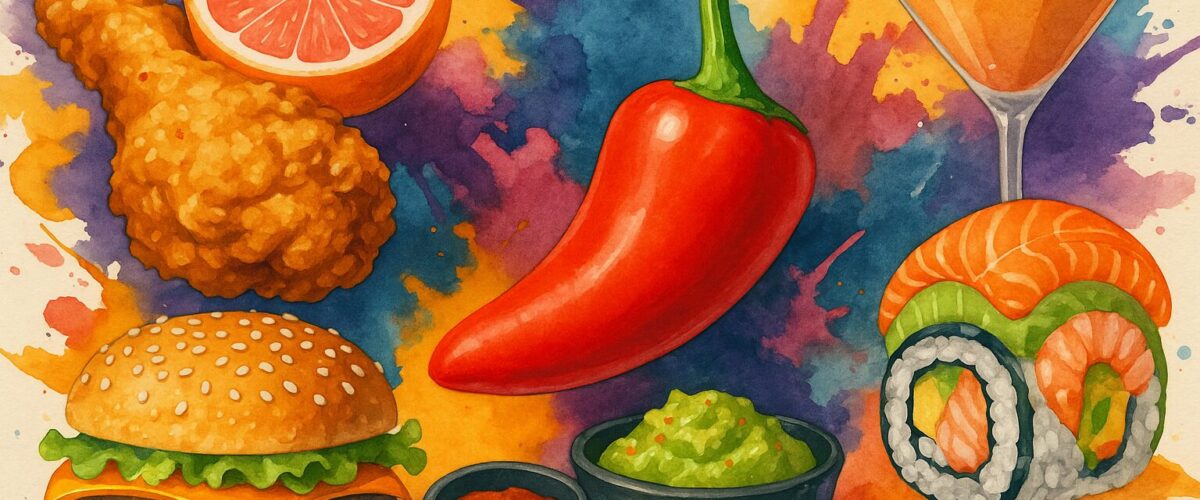Comfort food still has its place—but in 2025, curiosity is driving the culinary conversation. Diners across the globe are craving flavours that surprise, challenge, and excite. Gone are the days when “a hint of heat” or “a touch of citrus” felt daring. Today’s food lovers are embracing fermented funk, searing spice, and tart-sweet combos that tease the senses.
What’s behind this shift? A more adventurous Gen Z palate, global flavour crossovers, and the influence of social media challenges that celebrate intense eating experiences. Chefs and brands are responding with layered, bold creations—from habanero sorbet to kimchi-laced margaritas. The modern diner isn’t asking for safe. They’re asking for new.
Trend Snapshot / Factbox
| Aspect | Details |
|---|---|
| Trend name and brief definition | Bold Flavour Revolution: A shift toward intense, unexpected, and globally influenced taste experiences |
| Main ingredients or key components | Ferments, spicy condiments, sour fruits, bitter herbs, umami-rich pastes |
| Current distribution | Global, with strong scenes in Asia, Europe, and North America |
| Well-known restaurants or products currently embodying this trend | Momofuku (US), Kol (UK), Fonda (Mexico City), Lökka (Berlin), Omsom (US-based sauces) |
| Relevant hashtags and social media presence | #flavourchallenge #spicytok #umamibomb #tasteexplosion #foodadventure |
| Target demographics | Gen Z, Millennials, urban foodies, flavour-forward snackers |
| “Wow factor” or special feature of the trend | Pushes sensory boundaries with heat, acid, bitterness, and fermented depth |
| Trend phase | Peak curiosity – widespread, but still evolving |
The Rise of the Brave Palate
The days of one-note meals are fading fast. Around the globe, younger generations are rejecting the familiar in favour of the flavourful unknown. It’s not just about heat—it’s about intensity. Think numbing peppercorn oil, burnt citrus, tangy tamarind, and unexpected bitterness from wild herbs. This new palate thrives on complexity and challenge.
Inspiration comes from all corners: Korean street food, Sichuan fine dining, pickled Mexican fruits, and even Scandinavian bitter tonics. TikTok and Instagram have made flavour exploration a performative act. Users bite into ghost pepper wings, sip vinegar-laced sodas, or try exotic snacks like salted umeboshi and candied jalapeños—all on camera, all for the thrill.
Eating has become entertainment, and entertainment demands something new.
Fruity, Fermented, Fire: The New Flavour Trio
If there’s a signature of this taste revolution, it’s the triumvirate of fruit, funk, and fire.
On the sweet side, tropical fruit meets heat: think mango dusted with Tajín, pineapple marinated in chili oil, or passionfruit stirred into sambal. Fermentation is no longer reserved for miso or sauerkraut—new stars like pineapple vinegar, black garlic paste, and fermented green tomato chutney are turning up in everything from cocktails to desserts.
Restaurants and brands are playing with miso-yuzu caramels, citrusy gochujang dips, and sour guava salsas. Hot sauce is practically its own category now, with artisan versions featuring ingredients like Scotch bonnet, hibiscus, smoked tamarind, or even activated charcoal.
From tapas to tasting menus, flavour layering is key: acid, spice, sweetness, and umami, all doing a tightrope dance on the tongue.
“Today’s diners don’t just want flavour—they want a flavour story.”
The Dish Doesn’t Lie: Restaurant Experiments Worth Noting
Across cities like Berlin, London, Singapore, and LA, restaurants are building menus around boldness. A few notable dishes from recent menus:
- Miso mango ceviche served with chili-pickled radish and toasted rice
- Peanut butter dan dan noodles using Sichuan pepper, tahini, and vinegar
- Spiced black lime and burnt honey chicken with fermented lemon purée
- Crispy cauliflower with pineapple fish sauce caramel (seen at several Southeast Asian-inspired pop-ups)
- Kimchi-basil sorbet as a palate cleanser in avant-garde tasting menus
Even casual settings are joining in: Mexican-Korean fusion tacos, Ethiopian spice rubs in burger joints, and natural wines with aggressive acidity—all reflect this desire for strong, layered, and unusual flavours.
Experimental doesn’t mean alienating. The most successful dishes hit that sweet spot between intrigue and satisfaction. They take risks—but they’re rooted in flavour logic.
Not Just Gimmicks: Why Bold Flavours Build Loyalty
Bold flavours aren’t just for social media virality. When done right, they create memory. The guest doesn’t just remember “a nice sauce”—they remember the smoked chili marmalade that caught them off guard and made them want more.
This emotional engagement is powerful. It drives return visits, word-of-mouth recommendations, and online buzz. Brands that understand this are designing not just food, but flavour experiences: chips with layered heat, sparkling drinks with balsamic vinegar, or dips with intense fermentation depth.
Flavour fatigue is real in a crowded food market. Surprise, when balanced with craft, becomes a loyalty strategy.
Final Thought: Curiosity Is the New Comfort
In 2025, boldness sells. Consumers are not just tolerating risk—they’re actively looking for it. The new comfort lies in exploration, not repetition. Whether it’s a single dish that plays with fire or an entire menu that dares to challenge the palate, flavour-forward thinking is the new currency of relevance.
For chefs, developers, and food innovators, the message is clear: forget safe. Be sharp, be surprising—and above all, be brave.

